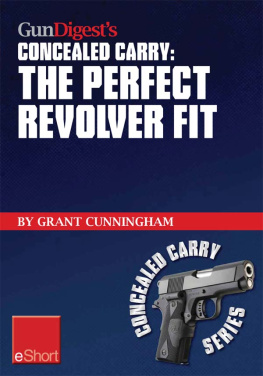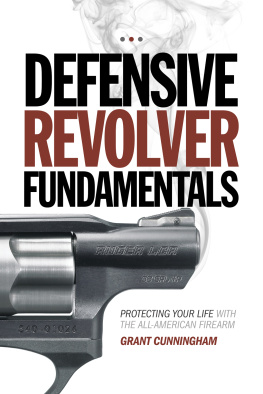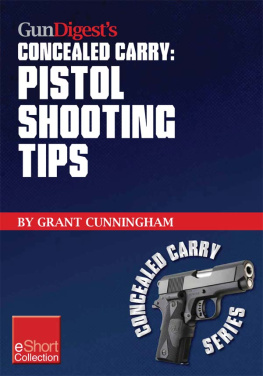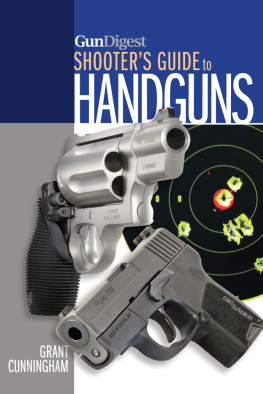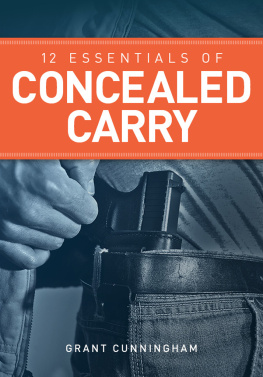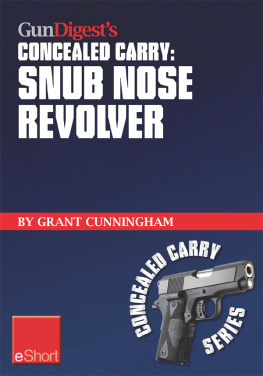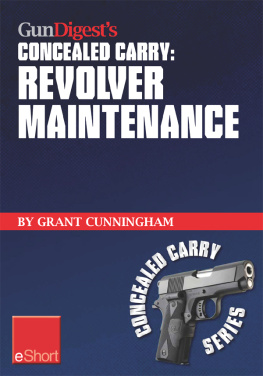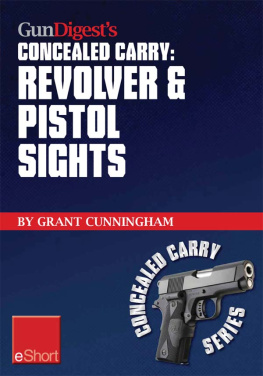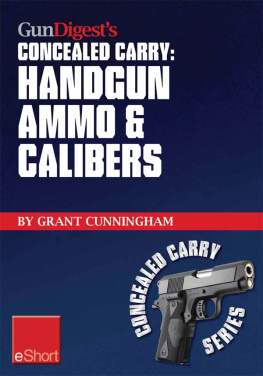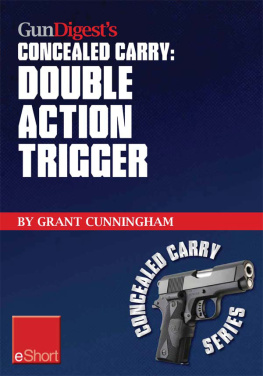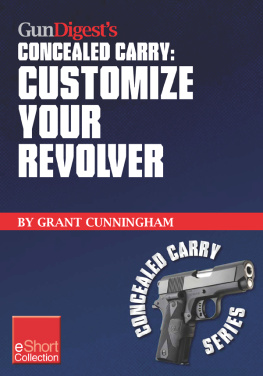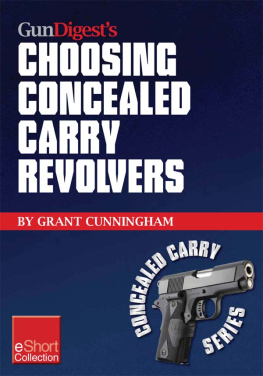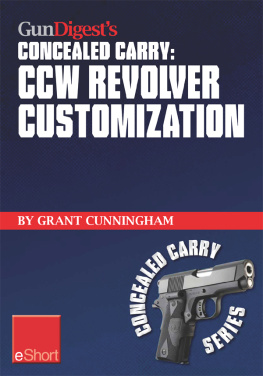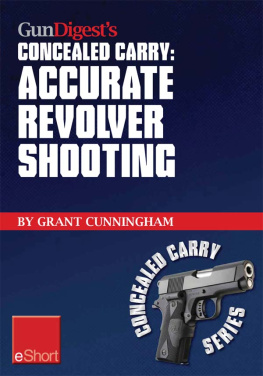Grant Cunningham - Gun Digests The Perfect Revolver Fit Concealed Carry eShort
Here you can read online Grant Cunningham - Gun Digests The Perfect Revolver Fit Concealed Carry eShort full text of the book (entire story) in english for free. Download pdf and epub, get meaning, cover and reviews about this ebook. year: 2012, publisher: F+W Media, genre: Home and family. Description of the work, (preface) as well as reviews are available. Best literature library LitArk.com created for fans of good reading and offers a wide selection of genres:
Romance novel
Science fiction
Adventure
Detective
Science
History
Home and family
Prose
Art
Politics
Computer
Non-fiction
Religion
Business
Children
Humor
Choose a favorite category and find really read worthwhile books. Enjoy immersion in the world of imagination, feel the emotions of the characters or learn something new for yourself, make an fascinating discovery.
- Book:Gun Digests The Perfect Revolver Fit Concealed Carry eShort
- Author:
- Publisher:F+W Media
- Genre:
- Year:2012
- Rating:3 / 5
- Favourites:Add to favourites
- Your mark:
- 60
- 1
- 2
- 3
- 4
- 5
Gun Digests The Perfect Revolver Fit Concealed Carry eShort: summary, description and annotation
We offer to read an annotation, description, summary or preface (depends on what the author of the book "Gun Digests The Perfect Revolver Fit Concealed Carry eShort" wrote himself). If you haven't found the necessary information about the book — write in the comments, we will try to find it.
In this excerpt from the Gun Digest Book of the Revolver, Grant Cunningham shows why revolver fit is so important and how to find the perfect fitting pistol for CCW.
Gun Digests The Perfect Revolver Fit Concealed Carry eShort — read online for free the complete book (whole text) full work
Below is the text of the book, divided by pages. System saving the place of the last page read, allows you to conveniently read the book "Gun Digests The Perfect Revolver Fit Concealed Carry eShort" online for free, without having to search again every time where you left off. Put a bookmark, and you can go to the page where you finished reading at any time.
Font size:
Interval:
Bookmark:


Its really pretty simple: your gun must fit your hand if you want to be efficient in shooting. The circumference of the grip, the distance from the back to the trigger, and even the shape of the grips cross section make huge contributions to comfort and performance.
Were lucky to be talking about revolvers in this day and age as opposed to just a few decades ago. Back in the 70s, and even well into the 80s, very few revolvers came with grips that actually fit a shooters hands. Custom grip manufacturers existed, but there was no internet to help shooters find them. If the revolver owner didnt read a gun magazine, or sometimes the right gun magazine, he or she would never learn that they didnt have to suffer with poor revolver fit!
Today we have a wide range of aftermarket grips available, and many more that can be had on a custom basis through the many gripmakers found on the internet. Technology has improved, giving us materials that simply werent available some forty years ago. We also understand more about the role of improved ergonomics in shooter performance.
Many of these changes came about because of the wave of shall issue concealed carry that swept across America during the 1980s. The market for concealed carry guns, training, and accessories exploded, bringing new ideas and increased competition into what was a pretty hidebound industry. Were it not for that, we might not have seen the need for proper gun and hand fit achieve the recognition that it has.

When fitting a gun to a shooter I always start with the trigger/finger interface. Ill talk more about trigger finger placement in a later chapter, but ideally the first joint of the finger should be placed on the trigger. This is the ideal point of leverage and muscle control, and fits the majority of shooters with the widest range of gun sizes.
The process starts by having the student place that finger joint on the trigger. Once thats properly placed we work backwards to the proper grip. Once the trigger finger is in the right place its easy to see if the the rest of the hand fits the gun (or vice-versa, depending on how you look at things).
With the finger placed properly on the trigger and the rest of the fingers curled around the grip, I check to see if the barrel lines up with the bones of the forearm. If the gun is too big for the persons hand, the barrel will be pointing away from the centerline of the body. If the gun is too small, it will be pointing toward the centerline.
Ive found that its easier for most people to shoot a too-small gun than to operate a too-large gun. To get enough leverage to operate the trigger, a person with small hands (such as mine) must rotate the hand toward the muzzle, bringing the finger further into the trigger for proper leverage. This puts the backstrap of the revolver, which is the center of the recoil impulse, not into the palm but on the outside edge of the base of the thumb. The first bone of thumb itself, which now sits on the top of the backstrap instead of alongside it, takes the punishment of the muzzle flip. I can tell you from experience that this is a painful situation in which to be!
Someone with hands that are a bit big for the gun usually suffers nothing more than interference problems. The large trigger finger often contacts the thumb as it strokes the trigger backward, throwing the gun slightly off target and necessitating careful attention to the sights. Some of this is alleviated through proper trigger control (which is coming up in Chapter Five), but very large hands on very small guns are always a problem.
Thats why, if a choice has to be made, Ill recommend the smaller gun every time. For the best results, though, the fit should be as close to ideal as possible.
How to deal with this mismatch? The usual fix is to find grips, either smaller or larger, that will better fit the shooter. By carefully choosing the grip its possible to compensate for a difference between the shooters hand and the revolvers size, but sometimes thats not practical (perhaps there are concealability issues) or even possible (grips arent available for the revolver in question or cant be made small enough to make a difference.)
In those cases my recommendation is for the shooter to obtain a revolver with a different frame size, one that is more suitable for his/her hand. This isnt always met with a welcoming attitude. We tend to get attached to our possessions, even more so if the gun was a gift or inheritance. I understand those issues, and sympathize with them more than you might think, but if the goal is to shoot well sometimes a different gun is the only answer.

Frame sizes are really nothing more than a shorthand to tell us into what general size category (or class) the gun fits. Unfortunately, unlike the automobile world, they arent standardized to compact/subcompact categories. Every maker has their own way of referring to frame sizes, and they arent always compatible. This makes it difficult to judge if any given gun fits a particular set of size parameters.
Smith & Wesson frame sizes tend to be the most universally used as reference points, and I wont buck that trend. Lets take a look at S&W frame nomenclature, then compare some of their competitors strictly in terms of size.
Their smallest frame size is the J series, which historically was a five-shot revolver chambering a .38 caliber cartridge. Over the years theyve accommodated other calibers in different capacities and made of different materials, but the frame size remains largely unchanged. When small concealment revolvers are mentioned, particularly those intended for pocket or ankle carry, the gun almost invariably meant is some variation of the J-frame.
There have been several major variations in the J-frame lineup, referred to by the original model that had the feature set. These various model lines themselves are often used as descriptors even if the gun itself was never officially part of that line. There are the Centennials, which have internal hammers; the Bodyguards, which have shrouded, but still accessible, hammers; and the Chiefs Specials, featuring conventional external hammers. While not all J-frames were necessarily part of those lines, theyve come to be used generically to describe the overall appearance and feature set of any given J-frame.
If I say Centennial, you know Im talking about a concealed hammer model like the 42, 640, or 340. If I say Bodyguard, you know its going to have a shrouded but cockable hammer like the Model 38 or 638. If Im talking about the Chiefs Special you can discern the Model 60, 36 and 637. This list is not all inclusive; there are many more, as the J-frames are among Smith & Wessons most popular revolvers.
Font size:
Interval:
Bookmark:
Similar books «Gun Digests The Perfect Revolver Fit Concealed Carry eShort»
Look at similar books to Gun Digests The Perfect Revolver Fit Concealed Carry eShort. We have selected literature similar in name and meaning in the hope of providing readers with more options to find new, interesting, not yet read works.
Discussion, reviews of the book Gun Digests The Perfect Revolver Fit Concealed Carry eShort and just readers' own opinions. Leave your comments, write what you think about the work, its meaning or the main characters. Specify what exactly you liked and what you didn't like, and why you think so.

